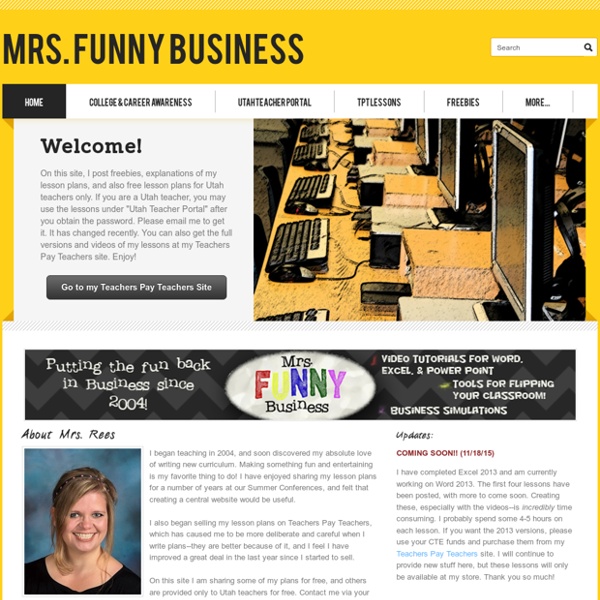



http://meganreescurriculum.weebly.com/
How Do Rubrics Help? Rubrics are multidimensional sets of scoring guidelines that can be used to provide consistency in evaluating student work. They spell out scoring criteria so that multiple teachers, using the same rubric for a student's essay, for example, would arrive at the same score or grade. Rubrics are used from the initiation to the completion of a student project. They provide a measurement system for specific tasks and are tailored to each project, so as the projects become more complex, so do the rubrics.
Rubrics to the Rescue By Melissa D. Henning, M.Ed. Read this teacher-friendly article for an overview of the rationale for using rubrics and tools and tips for implementing rubrics as an assessment tool in your classroom. Understanding Rubrics by Heidi Goodrich Andrade Understanding Rubrics by Heidi Goodrich Andrade Authentic assessments tend to use rubrics to describe student achievement. At last, here’s clarity on the term. Every time I introduce rubrics to a group of teachers the reaction is the same — instant appeal (“Yes, this is what I need!”) The Ten Commandments of Effective Classroom Management The Ten Commandments of Effective Classroom Management By William Shoap closeAuthor: William Shoap Name: William ShoapSite: See Authors Posts (1) William Shoap posted these commandments on the Classroom Management chatboard, and we thought them worthy of sharing here. One of the biggest barriers to teaching and learning in any school environment is the lack of effective classroom management methods. Failure to manage student behavior and learning at the classroom level is the main culprit for low student achievement and classroom behavior problems.
Guidelines for Online Teaching Success Years ago at a faculty meeting Larry Ragan, PhD, director of Faculty Development for Penn State’s World Campus, was trying to soft-sell the idea of performance expectations for online faculty. He didn’t want the discussion to be misinterpreted as an indictment against their teaching style, but he also saw an opportunity to share proven practices for improving the online teaching and learning experience. Finally a senior faculty member grew tired of the tip-toeing around the subject and said, “If you don’t tell us what is expected, how will we know what to do to succeed?”
Scoring Rubric: Business Letter/Memo Printable (6th - 12th Grade) Hanukkah Celebrate the Festival of Lights in your classroom! Hanukkah begins at sundown December 6. December Calendar of Events December is full of events that you can incorporate into your standard curriculum. Our Educators' Calendar outlines activities for each event, including: World AIDS Day (12/1), International Volunteer Day (12/6), Hanukkah (begins at sundown 12/6), Handwashing Awareness Week (12/6-12), Computer Science Education Week (12/7-13), Human Rights Day (12/10), Winter Solstice (12/22), Christmas (12/25), Kwanzaa (begins 12/26), Visit the Zoo Day (12/27), and New Year's Eve (12/31). Plus, celebrate Bingo's Birthday Month, Universal Human Rights Month, and Write to a Friend Month all December long! Hour of Code Introduce your students to basic coding and computer science!
A Turn to Learn: September 2012 This idea is actually a gem that one of my students thought of a few years ago! One of my classes' favorite YouTube videos was this one... "If You're a Boy" from Harry Kindergarten. Well... my kids were chatty one day and I said "If you're a boy zip your lips." One of my girls said "If you're a boy, a boy, if you're a boy zip your lips!" And so a new tradition was born!
Blog I am grateful for… With Thanksgiving just around the corner, I am taking some time to reflect on just how very fortunate I am. Since becoming a connected educator in 2011, my learning world has expanded beyond my expectations and then some. Top 10 FREE Plagiarism Detection Tools for Teachers - eLearning Industry Editor's note: We have originally written and published this article in November 2013. Thanks to your useful suggestions and our own following of the latest developments in the fast paced field of technology, we have updated this piece in October 2015 in the hope that you will keep finding it useful. Thank you for sharing! The act of taking someone else’s ideas and passing them off as your own defines the concept of “plagiarism”. As it is shown by the growing educational concerns, plagiarism has now become an integral part of our digital lives as technology, with the billions of information it gives us access to, led to the exacerbation of this phenomenon.
Internet and Technology Lesson Plans Resources for School Librarians - Index Menu for This Page: General Technology Lesson Plans | Searching the Web | Web Quests | Internet Safety and Digital Citizenship Lesson Plans | Resources for Teachers | General Technology Lesson Plans Basic Computer Skills Curriculum - This is a good place to start if you are teaching students with little or no knowledge of computers. brainpop Whether your students are using Apple©, Android™, Windows 8, or Chrome™ devices, there’s a BrainPOP app for you. Ideal for BYOD (Bring Your Own Device) and other mobile learning environments, mobile access is now an integral part of all BrainPOP Jr. (K-3), BrainPOP, and BrainPOP Español subscriptions.
10 New Educational Web Tools for Teachers Below is a list of some important educational web tools I have handpicked for you from a variety of blogs and websites. As you know by now, the purpose behind such round-ups is to update teachers and educators with the latest releases in the world of educational technology. Our Educational Web Tools page is growing bigger and bigger and now features hundreds of web tools that are all, in a way or another, relevant to us in education. Check it out to access the previous versions. Here are the titles I have for you today: Business Communication Headline News Teaching Methods and Materials « Previous Entries The Flipped Classroom Model: A Full Picture Wednesday, April 2nd, 2014 "Due to Khan Academy’s popularity, the idea of the flipped classroom has gained press and credibility within education circles.